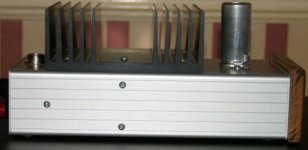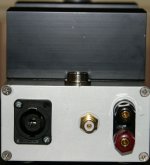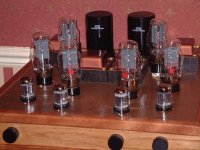Banned
Joined 2002
Nuuk said:G'day Joe. I'm getting a shopping list together to build a valve buffered IGC based on your design and I have been re-reading your DIY page.
I have one question about the filter components. The values that you have in your circuit diagram are 4k7/1n3 which according to my calculations comes out at 25,505Hz. But I thought that the idea was to filter out anything above 32K. Am I right in thinking that the filter starts at 25,505 and cuts eveything off by the time we get to 32K?
We don't seem to be able to get 1n3 here in the UK (at least not from Farnell) so I presume that 5K1/1n2 will do the job just as well (and I'll get some other values to try as well)
Now back to fridge for a cold drink - it's hotter here than a hot day in Laverton, WA!
The 4K7 value into 1n3 is a bit deceptive. Take into account the effect the 18K resistor which goes to a virtual earth (-) on the GC.
So you must parallel 4K7 and 18K which is 3K726 - now calculate the filter into 1n3. This is about 33KHz.
Do use 1n2, I noticed that some have used two times 680pF in parallel as well. When we, a friend and I, settled on 1n3, we had a whole bunch of 1% non-inductive polystyrene caps. We selected on the basis on what we had. Curiously we had no 1n2. As I have many hundreds of 1n3 that is what I'm using. I won 't be running out for a long time, lucky me.
Try both 1n2 and 1n5 - and settle on what you like and then pass that on. Try more if you will, let your ear and not me, be your final arbiter.
The rate of the LPF is 6dB/octave - it is almost purely passive and has no active affect on the 3875. Again because of the virtual earth, the filter is isolated.
I've heard the weather has been unusually hot up there. I have relatives in Denmark and Norway - so I know. Allen Wright said it's been hot in Munich as well. It is mid winter here, we have had very little rain - in fact away from the coast we are in the grip of a drought, the worst they reckon, in nearly one hundred years. On most days we top at around 20C, not bad for winter, in fact one day last week we got 24C. Today, another clear blue sky.
Talking about Allen (since so many of you know him) he liked my best [audio] friend:
An externally hosted image should be here but it was not working when we last tested it.
BLACK BEAST MK-IV
http://members.ozemail.com.au/~lisaras/DIY/BB-IV-55-2.jpg
Joe R.
Hi
Frank
I have those on order from Langrex Supplies,i was worried the edicrons would be microphonic hence the alloy can..I got hold of 6 of these el cheap all were pretty decent.(Yes Nick i did try yours before sending). )
)
A BIG THANKYOU To Joe :--))))) They sound wonderful..
Regards
Peter
Frank
I have those on order from Langrex Supplies,i was worried the edicrons would be microphonic hence the alloy can..I got hold of 6 of these el cheap all were pretty decent.(Yes Nick i did try yours before sending).
A BIG THANKYOU To Joe :--))))) They sound wonderful..
Regards
Peter
Hi Peter,
Good on you... nothing to do with Edicron as such but the NOS tubes are heaven compared to the China ones.
The screening can isn't a bad idea, it will...well screen the valve at the expense of only a neglegible amount of input capacitance and it will help reduce microphony too.
Guess it's time to do some cross-pollenation and invite you guys to the truly weird world of valves at the "Tubes" section...you might just find something like your true calling...
Sorry Joe Rasmussen...I'm only trying out some new marketing ploy here...
Cheers,
I have those on order from Langrex Supplies
Good on you... nothing to do with Edicron as such but the NOS tubes are heaven compared to the China ones.
The screening can isn't a bad idea, it will...well screen the valve at the expense of only a neglegible amount of input capacitance and it will help reduce microphony too.
Guess it's time to do some cross-pollenation and invite you guys to the truly weird world of valves at the "Tubes" section...you might just find something like your true calling...
Sorry Joe Rasmussen...I'm only trying out some new marketing ploy here...

Cheers,
The 4K7 value into 1n3 is a bit deceptive. Take into account the effect the 18K resistor which goes to a virtual earth (-) on the GC.
Thanks Joe, I thought there must be another factor involved and was forgetting that my OPA627 buffered IGC doesn't have the 18K to ground, hence the different filter values.
I'll be using the 18K and in fact your exact circuit to build the valve buffered ICG and yes, I will experiment with the filter values.
I will also be in the fortunate position to compare a basic ICG with the two buffered versions!
By coincidence, there has just been an article on Radio 4 about water and how many people are short of it in the world. They were saying how we take it for granted in places like the UK but the way the climate IS changing, that may change!
Now, what's with these valve-heads coming here and trying to lure us into the seedy world of heat-producing large lumps of iron and glass?
Ironically, it was the valve section that first drew me to diyAudio but then I found the Chip amp posts and have never looked back.
Hey nick hurry up with the wooden knobs,I can then finish the controller.))
Hey Peter, I believe that when working with wood, we should work at the same pace that the tree did in producing the wood.

Nuuk said:I'll be using the 18K and in fact your exact circuit to build the valve buffered ICG and yes, I will experiment with the filter values.
Hi,
IMHO, value of C in LPF strongly depends on speaker quality (and one's own taste, of course). Initially I started with 2*680pF and the sound I got on moderate Sony speakers (aggressive highs etc..) was OK. But by using other, high quality speakers (Accuton high drivers), I was able to get a much better result with only one C (680pF, MKC, 2,5%).
Regards
IMHO, value of C in LPF strongly depends on speaker quality (and one's own taste, of course). Initially I started with 2*680pF and the sound I got on moderate Sony speakers (aggressive highs etc..) was OK. But by using other, high quality speakers (Accuton high drivers), I was able to get a much better result with only one C (680pF, MKC, 2,5%).
Thanks for that Moamps, it's obviously worth having a few different values to play with.
Actually, I guess that many of us are (or should be) using less than optimum speakers for doing out intial testing and as you say, things can change quite a bit when we then connect up our better speakers. I have found that to be the case even with the basic UGC!
fdegrove said:Hi Peter,
Good on you... nothing to do with Edicron as such but the NOS tubes are heaven compared to the China ones.
The screening can isn't a bad idea, it will...well screen the valve at the expense of only a neglegible amount of input capacitance and it will help reduce microphony too.
Guess it's time to do some cross-pollenation and invite you guys to the truly weird world of valves at the "Tubes" section...you might just find something like your true calling...
Sorry Joe Rasmussen...I'm only trying out some new marketing ploy here...
Cheers,
ALL I CAN SAY IS: YOU HAVE NO IDEA!!!!

http://www.vacuumstate.com/pow-amp.htm
Joe R.
Nuuk said:Hey Joe, where can we find out more about that BLACK BEAST MK-IV! Looks interesting. I presume that the top section is an open baffle arrangement.
moamps said:
Hi,
IMHO, value of C in LPF strongly depends on speaker quality (and one's own taste, of course). Initially I started with 2*680pF and the sound I got on moderate Sony speakers (aggressive highs etc..) was OK. But by using other, high quality speakers (Accuton high drivers), I was able to get a much better result with only one C (680pF, MKC, 2,5%).
Regards
OK, I got no problem with that. The LPF is not set in cement. It would be interesting, over a period of time, as others hopefully do experiment, if a preferred setting emerges.
I tell you that some metal-domed tweeters with HF resonance, could well benefit from more aggressive LPF.
Joe R.
Nuuk said:Hey Joe, where can we find out more about that BLACK BEAST MK-IV! Looks interesting. I presume that the top section is an open baffle arrangement.
Unless you can unlock my head...
No, actually no great secrets here, I would be glad to tell, but I wouldn't know where to start.. and this is not the right forum.
But, yes it is an open baffle, something I've been doing and experimenting with for 15+ years. I am a big fan of open baffle, and the best way to do it is as an MTM array. The sloped rear right angle piece is also crucial.
Perhaps soon I will get over there in the right forum and spill some more.
For a taste of one of my other activities:
Check out my Critical Q Sub-Woofer Project? A Sub with extremely low distortion achieved without a Servo.
http://members.ozemail.com.au/~joeras/sub_index.htm
Check out the ultra-clean 20Hz sine wave (from mic pick-up) and 40Hz based THD graph.
http://members.ozemail.com.au/~joeras/critical_q_sub_clio.htm
Coming back to Chip Amps:
Yes, do please use my values and vary LPF shunt cap by ear, and let us know about your buffer comparisons. Chip Amps will also help keep the planet cool!
In fact, Chip Amps are cool!

Joe R.
- Status
- This old topic is closed. If you want to reopen this topic, contact a moderator using the "Report Post" button.
- Home
- Amplifiers
- Chip Amps
- Tube with Power IC Output Stage - JLTi




